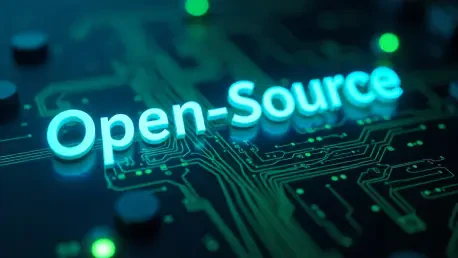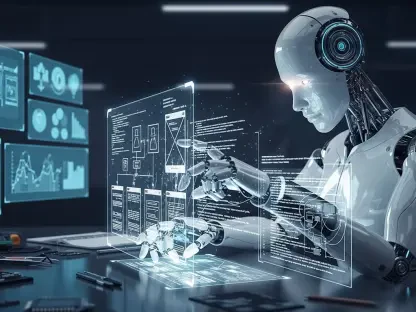Imagine a world where advanced artificial intelligence tools, once locked behind the walls of corporate giants, are now accessible to anyone with a laptop and an idea, shaping a reality driven by open-source language models. This transformative force in the AI landscape empowers developers, researchers, and small businesses alike. These models, with their publicly available architectures and weights, have sparked a wave of innovation, challenging the dominance of proprietary systems and redefining how technology is built and shared. This review dives into the intricacies of open-source large language models (LLMs), exploring their architectural designs, training methodologies, real-world applications, and the hurdles they face in a competitive field.
Architectural Innovations Driving Efficiency
Mixture-of-Experts (MoE) Structures
At the heart of many open-source LLMs lies a design known as Mixture-of-Experts, a strategy that optimizes computational resources by activating only a subset of parameters for each task. Models like GPT-OSS and DeepSeek V3 exemplify this approach, selectively engaging specific “experts” during inference to handle complex inputs without overwhelming hardware. This selective activation not only reduces energy consumption but also allows scaling to massive parameter counts, such as DeepSeek V3’s staggering 671 billion parameters, while keeping active usage manageable.
The significance of MoE extends beyond raw efficiency; it represents a shift toward sustainable AI development. By balancing scale with resource constraints, these structures enable deployment on consumer-grade devices, broadening access to high-powered tools. Such designs are pivotal for organizations lacking the infrastructure of tech giants, ensuring that cutting-edge technology isn’t confined to elite circles.
Advanced Attention Mechanisms
Another cornerstone of open-source LLM innovation is the evolution of attention mechanisms, which enhance memory efficiency and the ability to process extended contexts. Techniques like Grouped Query Attention (GQA), seen in models such as Qwen3 and GPT-OSS, streamline computation by grouping queries, thus reducing memory overhead. Meanwhile, DeepSeek V3 introduces Multi-head Latent Attention, compressing data into a latent space for superior handling of long sequences.
These advancements tackle a critical challenge in AI: maintaining performance over lengthy inputs. With context windows now exceeding 128,000 tokens in models like Qwen3, thanks to mechanisms paired with scaling techniques, applications requiring deep contextual understanding—such as legal document analysis or historical research—become feasible. This progress marks a leap toward more versatile and practical AI systems.
Training Strategies and Data Dynamics
The backbone of any powerful language model is its training methodology, and open-source LLMs showcase a spectrum of approaches to data handling. Qwen3, for instance, leverages an unprecedented 36 trillion-token dataset, employing a multi-stage training process that includes specialized phases for extending context capabilities. Such scale underscores the importance of data volume in achieving nuanced language understanding.
Beyond sheer quantity, the quality and safety of training data are paramount. Models like GPT-OSS integrate safety filters inspired by proprietary counterparts to mitigate harmful outputs, while employing techniques like YaRN to stretch context windows during pre-training. Variations in applying these methods—whether at inference or through staged fine-tuning—highlight an experimental ethos in the field, where adaptation drives progress.
Balancing these elements remains a delicate act. While massive datasets fuel capability, they also raise concerns about bias and ethical use, prompting developers to refine curation processes. This ongoing effort to harmonize volume with responsibility shapes the trajectory of open-source AI, ensuring relevance across diverse user needs.
Performance in Real-World Scenarios
Open-source LLMs are not just theoretical marvels; their impact is tangible across industries. In education, these models power personalized learning tools, adapting content to individual student needs. Software development benefits too, with models like GPT-OSS, available in quantized formats, enabling coders to integrate AI assistance on modest hardware without sacrificing performance.
Unique use cases further illustrate their versatility. DeepSeek V3, with its tool-calling features, supports complex workflows in research settings by interfacing with external systems, while Qwen3’s hybrid thinking modes blend reasoning and creativity for nuanced outputs. These capabilities empower smaller organizations and independent developers, leveling the playing field in a domain once dominated by resource-heavy entities.
Accessibility is the linchpin of this revolution. By lowering barriers to entry, open-source models foster a collaborative ecosystem where innovation thrives outside traditional power structures. From startups crafting niche applications to academics exploring new frontiers, the ripple effects of this democratization are reshaping technology adoption globally.
Challenges Hindering Full Transparency
Despite their promise, open-source LLMs face significant obstacles in achieving complete transparency. While architectures and weights are public, the intricacies of proprietary data engineering and post-training processes often remain undisclosed, creating a formidable barrier to replication. This hidden “moat,” as industry experts describe it, preserves competitive edges for original developers.
Technical complexities compound the issue. Replicating the labor-intensive aspects of model refinement requires expertise and resources beyond the reach of many in the open-source community. Even with transparent blueprints, the lack of insight into curated datasets or specific tuning methods limits the ability to fully harness these models’ potential.
Community efforts are underway to address these gaps, with collaborative platforms and shared methodologies emerging as vital tools. Yet, overcoming entrenched barriers demands sustained innovation and a commitment to openness, ensuring that the ethos of accessibility isn’t undermined by selective secrecy.
Looking Ahead to Future Developments
The horizon for open-source LLMs is bright with potential, driven by trends toward greater efficiency and expanded capabilities. Advances in context window scaling, aiming for even larger spans over the next few years from 2025 onward, promise to unlock deeper analytical applications. Simultaneously, refined post-training techniques are expected to enhance user-facing performance without escalating resource demands.
Breaking through current transparency limitations stands as a critical goal. Anticipated breakthroughs in standardized data-sharing practices could dismantle some of the hidden barriers, fostering true reproducibility. Such progress would amplify the collaborative spirit of the open-source movement, aligning with broader goals of equitable technology distribution.
The long-term implications are profound, influencing industry standards and societal integration of AI. As these models evolve, their role in shaping accessible, ethical, and impactful solutions will likely redefine benchmarks, ensuring that innovation serves a wider audience while addressing complex global challenges.
Final Reflections
Reflecting on this exploration of open-source language models, it is evident that their architectural ingenuity, diverse training approaches, and real-world utility mark a significant chapter in AI history. Their ability to converge on high performance despite varied strategies underscores the robustness of current practices in the field. Challenges around transparency and replication persist as notable hurdles, yet the community’s momentum hints at forthcoming resolutions.
Looking forward, the next steps involve prioritizing collaborative frameworks to bridge knowledge gaps, encouraging standardized practices for data and process sharing. Investing in tools that simplify deployment for non-experts could further democratize access, ensuring that the benefits of these models reach untapped sectors. This journey, fueled by collective effort, points toward a landscape where AI becomes a universal asset, driving progress with inclusivity at its core.









